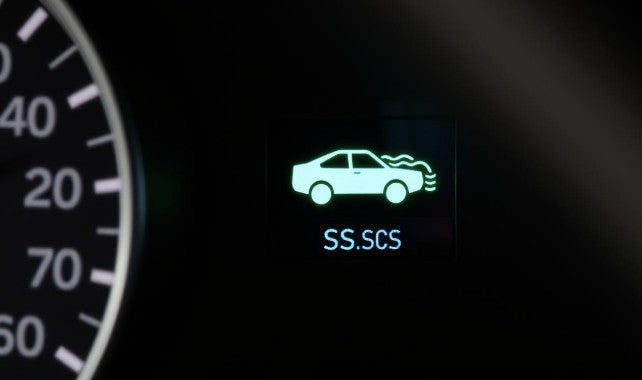Spotting the ESC light on your dashboard can be concerning, especially if you're unsure what it means for your safety. Electronic Stability Control (ESC) is a critical safety system designed to help prevent accidents. When that warning light illuminates, it's signaling something important about your vehicle's stability systems. This guide explains what the ESC light means, the risks of driving with it on, and the steps you should take to ensure your safety on the road.
What Is Electronic Stability Control?
Electronic Stability Control (ESC) is an advanced safety technology that helps drivers maintain control of their vehicles during challenging driving situations. Introduced in the 1980s by Bosch and Mercedes-Benz, ESC has become so vital to vehicle safety that since 2014, it has been a mandatory feature on all new cars sold in Europe and the United States.
The ESC system works by constantly monitoring your steering and vehicle direction. When it detects that your car is beginning to skid or lose stability, it automatically applies brakes to individual wheels and may reduce engine power to help correct your course and prevent a potential accident.
How ESC Works to Keep You Safe
The ESC system uses multiple sensors to detect when your vehicle is moving in a direction different from where you're steering. When this happens, the system:
- Applies brakes to specific wheels independently
- Reduces engine power when necessary
- Helps correct understeer or oversteer situations
- Works alongside your anti-lock braking system (ABS)
- Activates automatically without driver intervention
Studies show that vehicles equipped with ESC are 25% less likely to be involved in fatal accidents. The system is particularly effective in preventing rollovers and accidents caused by skidding, especially on wet or icy roads.
Why Does the ESC Light Come On?
The ESC warning light can illuminate for several different reasons, ranging from normal system activation to serious malfunctions. Understanding why your ESC light is on is the first step in determining whether it's safe to continue driving.
Normal System Activation
If the ESC light flashes briefly while driving, it typically means the system is actively working to maintain your vehicle's stability. This commonly occurs when:
- Driving on slippery roads (rain, snow, ice)
- Taking corners too quickly
- Accelerating rapidly on loose surfaces
- Experiencing momentary wheel slip or hydroplaning
A brief flash of the ESC light during challenging driving conditions is normal and indicates the system is functioning as designed.
System Manually Disabled
Many vehicles have an "ESC OFF" button that allows drivers to temporarily disable the system. If you've pressed this button, the ESC light will remain illuminated to indicate the system is not active. This is sometimes done intentionally when:
- Attempting to drive out of deep snow or mud
- During certain performance driving scenarios
- When using snow chains on tires
System Malfunction
If the ESC light stays on continuously without having pressed the ESC OFF button, it likely indicates a system malfunction. Common causes include:
- Faulty wheel speed sensors
- Steering angle sensor issues
- ABS system malfunctions
- Damaged wiring or connections
- Low battery voltage affecting electronic systems
- Issues with the brake light switch
A continuously illuminated ESC light requires attention, as it means your vehicle's stability control system is not functioning properly.
Need Help With Your ESC System?
Don't ignore that warning light. Our certified technicians can diagnose and repair your vehicle's stability control system to keep you safe on the road.
Risks of Driving With the ESC Light On
When your ESC light stays on due to a system malfunction, you're essentially driving without one of your vehicle's key safety features. This creates several important risks you should be aware of:
Driving With ESC Working
- Active skid prevention
- Improved control on slippery surfaces
- Reduced risk of rollovers
- Automatic correction during emergency maneuvers
- Enhanced overall vehicle stability
Driving With ESC Light On
- No automatic stability assistance
- Increased risk of skidding
- Reduced control in emergency situations
- Higher chance of accidents in adverse conditions
- Potential for more severe outcomes in critical situations
Specific Driving Scenarios With Increased Risk
The absence of a functioning ESC system is particularly dangerous in certain driving conditions:
|
Driving Condition |
Risk Level |
Potential Consequences |
|
Wet or icy roads |
Very High |
Severe skidding, inability to regain control |
|
High-speed highway driving |
High |
Reduced stability during lane changes or evasive maneuvers |
|
Sharp corners or winding roads |
High |
Increased risk of understeer or oversteer |
|
Heavy rain or standing water |
Very High |
No hydroplaning protection, loss of directional control |
|
Gravel or loose surfaces |
Moderate |
Reduced traction management, potential for sliding |
Safety Warning: Driving with a malfunctioning ESC system significantly increases your risk of losing control in emergency situations. This is especially dangerous in adverse weather conditions or during sudden evasive maneuvers.
What to Do When the ESC Light Comes On
If your ESC light has illuminated, follow these steps to address the situation safely:
Immediate Actions
- Assess the driving conditions: If you're on slippery roads or in bad weather, reduce your speed immediately and drive with extra caution.
- Check if the system was manually disabled: Look for an "ESC OFF" button that may have been pressed accidentally.
- Observe other warning lights: Check if the ABS light or other warning indicators are also illuminated, which can help identify related issues.
- Adjust your driving style: Drive more cautiously, leave extra space between vehicles, and avoid sudden maneuvers.
- Find a safe place to stop: If conditions are hazardous, consider finding a safe location to pull over until the issue can be addressed.
Next Steps for Diagnosis
Check Your Vehicle
- Inspect tire pressure and condition
- Look for visible damage to wheel sensors
- Check battery connections and voltage
- Verify brake lights are working properly
- Try restarting the vehicle to see if the light clears
Seek Professional Help
- Schedule a diagnostic scan with a qualified mechanic
- Have wheel speed sensors inspected
- Request a steering angle sensor check
- Get the ABS module examined
- Have the brake light switch tested
Don't Take Chances With Your Safety
Our ASE-certified technicians can quickly diagnose your ESC system issues and get your vehicle's safety systems back to optimal performance.
ESC System Repair Options
Once you've had your vehicle diagnosed, you'll need to address any issues found with the ESC system. Repair costs and complexity can vary widely depending on the specific problem.=
Common ESC System Repairs
|
Component |
Symptoms |
Typical Repair Cost |
Complexity |
|
Wheel Speed Sensor |
ESC light on, ABS light on, erratic speedometer |
$150-$300 per sensor |
Moderate |
|
Steering Angle Sensor |
ESC light on, steering feels off-center |
$200-$400 |
Moderate to High |
|
Brake Light Switch |
ESC light on, brake lights not working |
$50-$150 |
Low |
|
ABS Module |
Multiple warning lights, no ABS function |
$600-$1,200 |
High |
|
Wiring Harness Repair |
Intermittent ESC light, electrical issues |
$200-$500 |
Moderate to High |
DIY vs. Professional Repairs
While some ESC-related issues can be addressed by knowledgeable DIY mechanics, many repairs require specialized diagnostic equipment and expertise:
DIY-Friendly Repairs
- Replacing a brake light switch
- Cleaning wheel speed sensor connections
- Checking and replacing fuses
- Resetting the system after battery replacement
Professional Repairs Recommended
- Diagnosing complex electrical issues
- Replacing and calibrating steering angle sensors
- Programming new ABS modules
- Addressing internal hydraulic unit problems
Frequently Asked Questions About ESC Light Issues
Can I reset the ESC light myself?
In some cases, you can reset the ESC light by disconnecting your vehicle's battery for about 15 minutes. This may clear temporary electronic glitches. However, if the underlying issue hasn't been fixed, the light will likely return. For persistent ESC light issues, professional diagnosis is recommended.
Will the ESC light affect my vehicle inspection or emissions test?
Yes, in many regions, an illuminated ESC light is considered a safety system failure and can cause your vehicle to fail inspection. Since ESC became mandatory on new vehicles in 2014, functioning stability control is often part of the safety inspection requirements.
Is it legal to drive with the ESC light on?
While it's generally not illegal to drive with the ESC light illuminated, it may affect your vehicle's roadworthiness certification in some jurisdictions. More importantly, it means you're driving without a critical safety system, which could potentially affect insurance claims if you're involved in an accident.
Why does my ESC light come on when I apply the brakes?
If your ESC light illuminates when applying the brakes, it often indicates a problem with the brake light switch. This switch tells various vehicle systems when the brakes are being applied. A faulty switch can cause the ESC system to receive incorrect signals and activate the warning light.
Can bad weather trigger my ESC light?
Yes, driving in heavy rain, snow, or on icy roads can cause the ESC light to flash temporarily as the system activates to maintain stability. This is normal operation. However, if the light stays on continuously even in good conditions, there's likely a system malfunction that needs attention.
Will low tire pressure affect the ESC system?
Yes, improper tire pressure can affect ESC performance and potentially trigger the warning light. The ESC system relies on consistent wheel rotation speeds, which are affected by tire pressure. Always maintain proper tire inflation as specified in your owner's manual.
Still Have Questions About Your ESC Light?
Our experienced technicians can provide answers and solutions for your vehicle's electronic stability control system.
Conclusion: Prioritizing Your Safety
Driving with the ESC light on is not recommended, especially in challenging road conditions. While it may not render your vehicle immediately undrivable, it does mean you're missing a critical safety system designed to prevent accidents.
Electronic stability control has been proven to reduce accident rates significantly, particularly in situations involving skidding or loss of control. When your ESC light illuminates, it's sending an important message about your vehicle's safety systems that shouldn't be ignored.
For your safety and the safety of others on the road, address ESC system issues promptly. In most cases, the repair is simpler and less expensive than dealing with the potential consequences of an accident that might have been prevented by a functioning stability control system.
Remember that while modern vehicles have numerous safety systems, they all work together to provide comprehensive protection. Maintaining these systems in proper working order is an essential part of responsible vehicle ownership.
Drive With Confidence
Don't compromise on safety. Our certified technicians can diagnose and repair your ESC system quickly and affordably.




Leave a comment
This site is protected by hCaptcha and the hCaptcha Privacy Policy and Terms of Service apply.